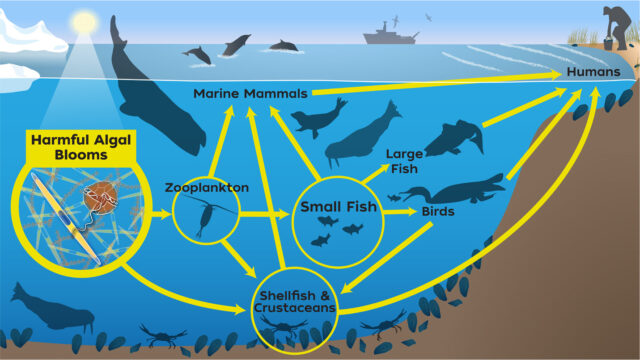Harmful algae. The phrasing itself almost seems it would be an oxymoron, like harmful carrots or something similar. But it is real: Given the right circumstances (light, nutrients), all algae can bloom and some of these can become Harmful Algae Blooms (HABs) if the algae can make toxins. It is most commonly cyanobacteria, dinoflagellates and diatoms that have this ability. Cyanobacteria are the most common reasons for HABs in freshwater, while dinoflagellates and diatoms are the most common reasons for HABs in salt water. HAB’s accumulate through the food web and are potentially lethal for animals and humans, so there are many good reasons to monitor, study and understand the origin, evolution, duration and behavior of HAB’s. LISSTs and in particular the LISST-HAB can help with this – read on!

Toxins from HABs accumulate via the food web, potentially affecting all aquatic organisms and humans consuming aquatic organisms. Figure from Anderson et al. (2022): https://doi.org/10.5670/oceanog.2022.121. Reproduced under Creative Commons 4.0.
How can Sequoia’s LISSTs Help?
Sequoia’s LISST-HAB instrument is a system solution, integrating three fluorometers onto Sequoia’s LISST-200X workhorse instrument. This enables detection of Phycoerythrin, Phycocyanin and Chlorophyll a pigment together with in situ particle size distribution (PSD), volume concentration, beam attenuation, temperature and depth all in one convenient data stream. All the data you need to calculate cell count of nano- and micro-plankton, as well as growth rates, sizes, and determine the dominant pigments.
It is important to realize that LISST-HAB and other LISSTS (with the exception of the LISST-Holo2) are limited to bloom monitoring. The reason is that in a diverse plankton community, laser diffraction cannot discriminate between species. However, in case of a bloom, there is typically only one dominant species so one can assume that all the particles measured by the LISST are the same.
If identification or grouping into different particle types is necessary, Sequoia’s LISST-Holo2 is suitable for obtaining particle images. The images then allow for identification or separating classes of particles (e.g. flocs, plankton) if desired.
Applications in the Field
HAB and algae researchers have used the data from the LISST-HAB and/or the LISST-200X/LISST-100X/LISST-100 in several ways:
- In-situ monitoring and vertical migration tracking of a cyanobacteria bloom: The LISST-HAB efficiently measured volume concentration, Chlorophyll a, and cyanobacteria size distribution. Cell counts matched microscope results (R2 ≥ 0.99), but were obtained much faster. Bloom distribution—both horizontal and vertical—depended on wind speed and direction. Other researchers have reported similar LISST-HAB findings.
- The LISST-100, predecessor of the LISST-200X, accurately measured phytoplankton cell dimensions for various shapes and sizes, and tracked increasing particle concentrations during a red tide bloom.
- Nano- and microplankton cell counts from an inverted microscope match LISST data closely. The LISST was then used to monitor a bloom in detail across time and space.
- LISSTs have shown great potential for synoptic bloom monitoring and study of bloom dynamics, e.g. patchiness.
- Diatom PSD, growth and aggregation processes have successfully been studied and quantified using LISSTs.
Summary
The LISST-HAB quickly delivers accurate fluorescence and particle size data, making it effective for cell counting, concentration, aggregation studies, and monitoring HAB blooms. Quantifying these metrics aids rapid decisions and deeper HAB insights. Other LISST models, like LISST-Holo2, can also help by providing particle images for identification.
